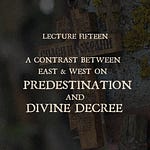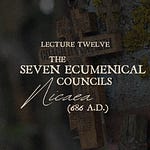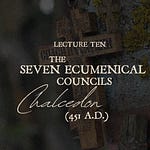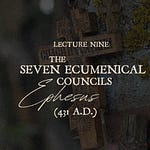These are transcripts from a spoken lecture. The audio is attached to this lesson. If there is any confusion from reading the transcript, please refer to the audio for clarification.
We’re continuing our march through the seven Ecumenical Councils. Last time we finished up Chalcedon, so Council number four. We have three to go, and today we’ll be looking at Constantinople two and three taken together.
Before we do that, let’s quickly rehash what we’ve already talked about. We saw that the early discussion, the discussion with Arius of Alexandria, concerned whether or not Christ was fully God. We saw that Arius had suggested that the Son of God, being begotten, must be a creature—a time when God was not a father, and he chose to then create a son. And so the Son is not truly God the way God the Father is.
Athanasius and the Council of Nicaea had insisted, no, that’s contrary to the teachings of Scripture and contrary to the faith once given over to the saints, that Christ is fully God. He is of the same nature as God the Father. He’s homoousios. He has the same nature as God the Father.
We also saw then at Constantinople how the Trinity itself was articulated, that the Trinity consists of three hypostases, three individuals or discrete subjects who have a common nature. Thus, it’s not just the Son of God who has the same nature as God the Father, but also the Holy Spirit has the very same nature as the Son and as the Father.
We also saw that at Constantinople, there now emerged questions concerning the Incarnation in Christ’s humanity. So Apollinaris had suggested as a proposal, well, perhaps how the Incarnation occurs is that man, consisting of an animal body, an animal soul, and a rational mind or spirit, is taken on, but the rational spirit is replaced—the Logos itself, being a rational spirit, takes that place in the man, and that’s how we get an incarnation.
But here emerged a central feature of how the Eastern fathers understand the gospel. They pointed out, or specifically Gregory of Nazianzus pointed out, that whatever is not appropriated is not healed. And here again, we saw the message of the gospel, according to the eastern fathers, is that the Son of God takes on our dying species, joining it with the divine nature, joining it with the divine life, in order to heal it and make it incorruptible and immortal. And thus, Gregory’s point is, if any aspect of our nature is not taken on, then that aspect of our nature is not healed. That will be actually quite relevant today at Constantinople two and three.
And thus there was an insistence that Christ is fully God. He’s not only homoousios with God the Father, but he’s homoousios with you and me. He has really become one of us and taken on our nature, the nature that is common to me and to you is the very same nature that he took on. And he took it on in total.
Then we saw arise this question at Ephesus, the question of whether or not there’s one person or two. And this question really emerged because Nestorius, the Patriarch of Constantinople, had a very peculiar notion, this peculiar idea that if somehow Christ were to take on divinity and humanity in one person, those would somehow merge and become a new type of nature, a new type of nature that is neither god nor man. Just like if we were to take human and horse and put them together, we get a centaur, which is neither horse nor man.
And thus, Nestorius proposed that what we really need is the Son of God as one person who has divinity. And when he takes on humanity, he also takes on humanity with another prosopon, and thus, as Cyril put it, Nestorius has two sons. There are two individuals, one who possesses humanity, one who possesses divinity, and these are somehow fused together or glued together. And this is Christ, and this is why Nestorius insisted that Mary is not Theotokos, the God-bearer, but the Christ-bearer, because what she births is this strained fusion of two sons of God.
That’s what Cyril suggested is entirely contrary to the teachings of Scripture. Scripture never speaks about a second person who walks around. It is the Word that became flesh and dwelt among us. It is the Word who suffered and died for us. It is the Word who imparts life to us and heals our nature. And thus, Cyril insisted that this strange notion must be dispelled. Both of the natures, though unconfused, are held together in only one person.
Cyril suggests that this happens all the time. You and I, for example, have two natures. Cyril pointed out we have a spiritual nature that is very different than our animal nature, but both are had and held together, unconfused, unmingled in one person. You are one such example. And so Cyril suggests there’s no danger of the natures mingling and becoming confused in the person of Christ—they are held together in a hypostatic union. They are held together in the one subject. And that’s why we can say that the Word became flesh and dwelt among us. And it’s also why he insisted that we say that Mary is the Theotokos, the bearer of God, or the bearer of the Son of God.
And we saw at Chalcedon how all of this came together. So following the Council of Ephesus, there arose certain heresies, such as Eutychianism or Miaphysicism, or Monophysitism, the idea that somehow the natures do, in fact, mingle. Eutyches talking about a drop of vinegar being dropped into the ocean and dissipating, and Chalcedon had to insist that both natures are held together, united in the hypostatic union, they are not confused.
And yet the balancing act that we saw is that though the natures are not confused, the divine nature does, in fact, energize the human nature. This is something that Nestorians had lost—in insulating the two natures one from another, they also insulated the one not energizing the other, but the insistence of Chalcedon, in keeping with Cyril, is that both natures are united in the one person of Christ and the Divinity energizes the humanity.
And we spoke about that this is not a mingling. And the reason it is not a mingling of natures, a confusion of natures, is because humanity, being an icon of God, is actually created to participate in the energies of God. This is a fulfillment of human nature, not a confusion of human nature. And thus we saw the complete statement of Chalcedon bringing together all of the decisions of the prior Ecumenical Councils in that articulation.
Constantinople 2 (553 A.D.)
So now we reach Constantinople two and three. I had said that we would hope that somehow Chalcedon, offering us such a clear statement of the prior councils, would bring unity, and this would be the end of the ecumenical discussions about Christology and the Trinity. After all, we’ve hit all the bases, right? But unfortunately, that’s not actually what happens.
Constantinople two in 553 A.D., let’s look at the context of this. Chalcedon itself, its aim was actually to unify folks. So the Miaphysites were particularly concerned about Nestorianism. They recognized that Nestorianism is quite heretical. They recognize that Nestorianism is a threat to the gospel. They recognize that with the Nestorians, you really insulate the natures one from another. They recognize that you don’t really have the Son of God coming into the world to save us. You have the Son of God sort of appropriating a man, which is not really what the incarnation is. And they also recognize, quite rightly, that the Nestorians denied the energizing of humanity, the healing of humanity. That’s the very purpose of humanity being porous and receptive to the divine nature. If we are not energized by the divine nature, then there’s no point in Christ taking on our nature. He takes it on in order to heal it.










